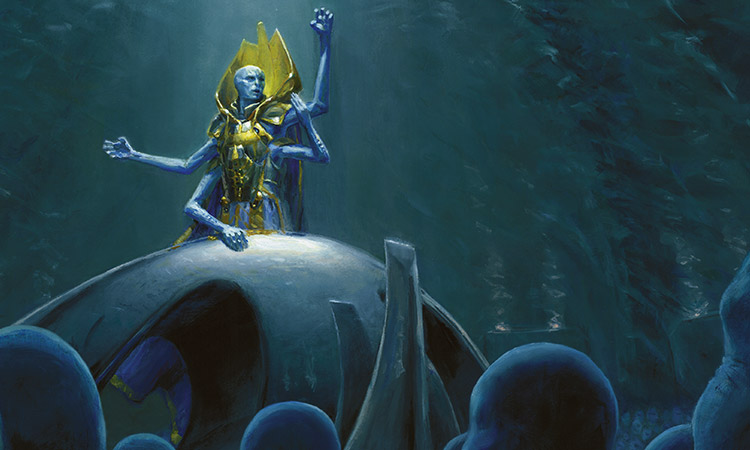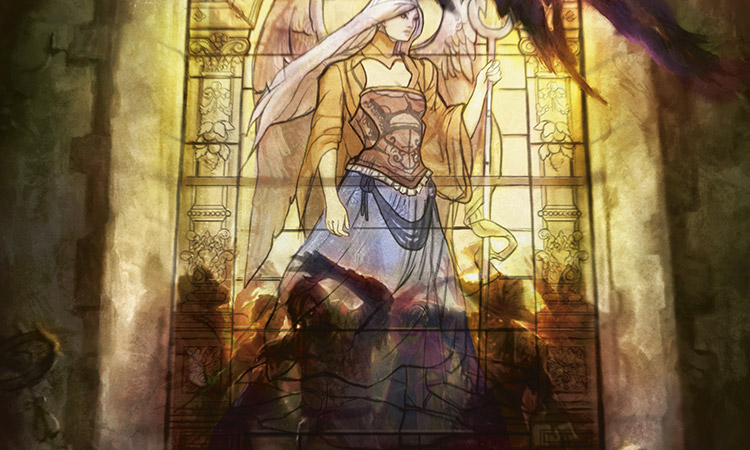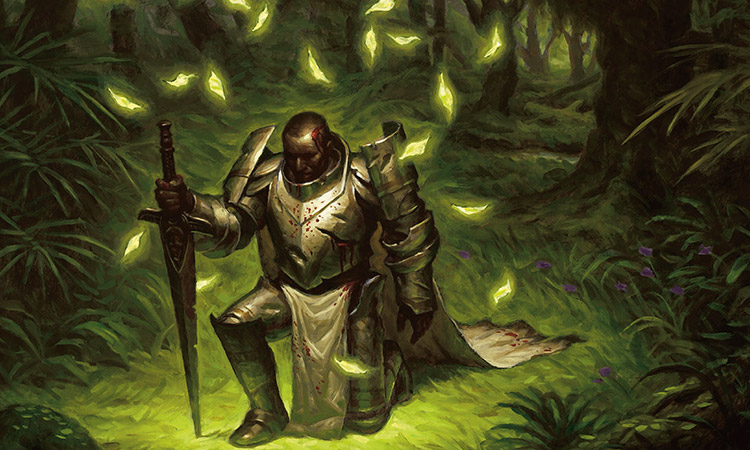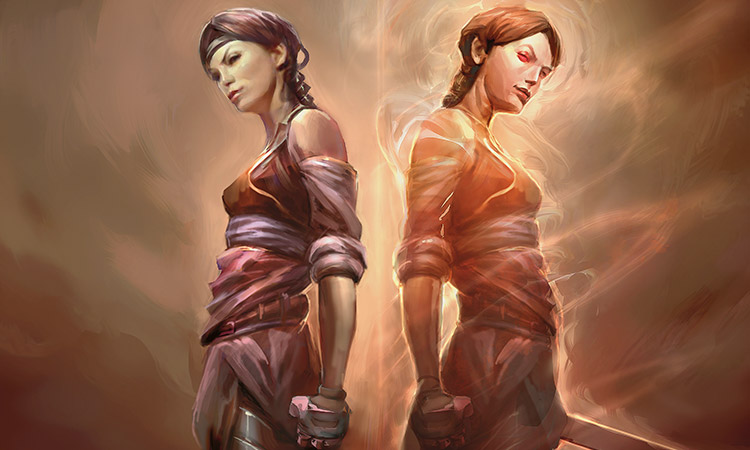Vorthos and Mel
It's Vorthos Week! Time to talk about the flavor fans of Magic. Back in 2007, I wrote an article all about Vorthos and his companion, Melvin (or Mel for short—more on the name in a second), in an article entitled "Melvin and Vorthos." Today's article is an update of that article, because in the last eight years I've had a lot of time to think about Vorthos and Mel, and I've come to realize that I was off about a thing or two. So I wanted to update you all on my thoughts.
Before we jump into the article, though, I want to talk a little bit about Melvin's name. Recently, I have come to realize that the player psychographics (Timmy, Johnny, and Spike) all having male-gendered names is not ideal for making everyone feel included. If I had to it to do over again, I would have chosen gender-neutral names. The names are a little too engrained in the player vocabulary to change, so I decided to create a companion female version—much like how "John Doe" has "Jane Doe." This would allow people to adapt the psychographics to either gender. Timmy got Tammy, and Johnny got Jenny. Spike is already a nickname—and of the four Spikes I've known in my life, three were female—so I decided Spike was fine left alone. This got me thinking about Vorthos and Melvin. Vorthos is a made-up name, so I decided it didn't have any cultural gendering to it and left it alone. For Melvin, I realized we could just shorten it to "Mel," as Melvin and Melanie both use Mel as a nickname. Since Melvin is probably the least used of all the names, I'm proposing we just shorten it to "Mel." From now on, that's what I'm going to use.
Let's Get Psychographical
There are a number of things I want to talk about, but let's start with the most contentious. Many people consider Vorthos and Mel the fourth and fifth psychographics. The problem is, they're not psychographics. Let me spend some time today explaining why they're not psychographics, and then explaining what exactly they are.
The point of a psychographic is to try to understand the psychological motivation behind why a person enjoys what they enjoy. It's not about the "what," but the "why." Now, this can get confusing, because when I talk about design, I focus on the "what." I talk about how a card appeals to Timmy or to Jenny. I talk about making a "Spike card" or a "Tammy card." I often appear to be very focused on the "what," because I'm trying to make something tangible. I think that can shift the focus away from what the psychographics actually indicate.

Grand Architect | Art by Steve Belledin
Why does Tammy or Timmy want to play Magic? They are eager to experience something. They seek an emotional and/or adrenaline rush. One way that some Timmies and Tammies experience this is with big creatures or spells. It can be exhilarating to cast a giant thing and watch it have a huge impact on the game. For other Timmies and Tammies, this rush comes from social interactions. It can be great fun interacting with your friends as you play. Yet other Timmies and Tammies like high-variance cards, because there's ongoing surprise. There's no constant "what" for Timmy and Tammy, because the thing that ties them all together is the "why."
Johnny and Jenny are the same. They want to use the game as a means to express something about themselves. For some, that is creative deck building. For others it's combos. For yet others, it is finding uses for cards in ways no one expects. The thread that connects Johnny and Jenny cards is likewise how those cards can be used as a means to psychologically satisfy this need. There is no other connection.
Spikes want to prove themselves. The game is a means of demonstrating what they are capable of. That might come from having the highest win percentage, or having the most people play the deck they tuned, or constantly bypassing accomplishments they set for themselves. Once again, the common bond of Spike cards is not "what" they are but "why" they satisfy Spikey players.
Vorthos and Mel, on the other hand, are about appreciating the "what." These two profiles are not psychological in origin, but aesthetic. They focus on how players appreciate elements of the game. How are those two things different? Aren't aesthetics an element of psychology?
Perhaps I can best explain with an analogy. Let's take an art museum. Suppose the people that ran the art museum wanted to create psychographics of their audience. What they would figure out is why people wanted to go to an art museum. Why did they psychologically get something out of it? Is it escapism? Is it inspiration? Is it motivation? Why does their audience come to the museum? Now, they also have to figure out the aesthetics of their audience. Do they like more modern pieces? Do they like brighter colors? Do they like bolder brush strokes? What makes them appreciate the paintings?
Both are important to understand. The first helps them figure out how to attract people to the museum and make them enjoy the experience while they're there. The second helps them deduce what art they want to have. Now, there is overlap. Certain styles of art can help reinforce certain psychological needs, but it's still a difference between "why" and "what."

Endless Ranks of the Dead | Art by Ryan Yee
Let's get back to Magic. There's no singular reason why Vorthoses are Vorthoses (or Mels are Mels). The label talks about what they appreciate. If you enjoy the flavor because the excitement of taking it all in is thrilling for you, then you're a Timmy/Tammy Vorthos. If you love using the story as a means to express yourself through something like an all-legendary Angel deck, then you're a Johnny/Jenny Vorthos. If you like being the known authority on all things story, then you're a Spike Vorthos. And these are just examples; there are many ways to combine Vorthos or Mel with the different psychographics.
So if Vorthos and Mel aren't psychographic profiles, what are they? I call them aesthetic profiles, as they focus on what aspect of the game you find the most beauty in.
What a Beauty
I want to talk for a second about beauty. Merriam-Webster defines beauty as "The quality or aggregate of qualities in a person or thing that gives pleasure to the senses or pleasurably exalts the mind or spirit." Or in other words, beauty makes you stop and reflect because it creates a strong sensation that forces you to observe it and then respond in, most often, a positive way.
I've spent years with the player psychographics, trying to get a better handle on what each one wants out of the game of Magic. This is important, because it's my job to make a game the players enjoy. To do that, I have to understand why the players enjoy it. To do that, I have to understand what they get out of it psychologically. This quest is what led to the creation of the player psychographics, which have in turn become a big tool used in R&D.
I bring this up because the aesthetic profiles have also proven very useful, but it's taken me time to understand and appreciate them. Vorthos was first created in a flavor column written by Matt Cavotta back in 2005, ten years ago. At the time, I used the psychographics mostly to focus on gameplay, and Matt felt that there were many players who enjoyed flavor aspects that were not being represented. Thus, he created Vorthos. (I would later spend more time explaining how the psychographics could interact with different facets of the game.) I later created Mel as a companion for Vorthos to represent what I thought, at the time, was the other end of the aesthetic scale (more on this in a moment). This meant that I spent a lot of time in the early years focused on why Vorthos and Mel weren't psychographics, but it took me time to start appreciating them for what they were. It also took a while to grasp how understanding what they represented would help us in making the game.

Sylvan Bounty | Art by Chris Rahn
I often talk about how I see Magic as art, how our creative endeavors are making more than just a product. We are making something that can be experienced and appreciated. Or in other words, I like to feel we are trying to make something beautiful. Psychographics explore why players enjoy the game, but aesthetics explain why players find it beautiful. Vorthos and Mel are just looking at two different vectors.
That brings me to my first big realization since I wrote my last article on this topic. At the time, I expressed Vorthos and Mel as being ends of a singular scale. I no longer believe that to be true. I feel that each one is looking at a different aesthetic scale and they represent the high extreme of that scale. There is a different person at the opposite end of the Vorthos or Mel scale, for example, that could care less about the things that Vorthos or Mel is attracted to, but I don't feel compelled to name the extreme of disinterest. (As people love labels, I'll just call them anti-Vorthos and anti-Mel.)
Let's take a look at what exactly Vorthos and Mel find beautiful.
Vorthos
I often talk about how, when designing, there are two different vantage points to start designing from. One is flavor and the other is mechanics. Starting with the first as the jumping off point is what we call top-down design, and starting from the second is referred to as bottom-up. Vorthos is the invested end of the Vorthos scale, which cares about the flavor. A Magic card has many elements on it that serve the function, or primary function, of conveying information about what the card represents thematically. It isn't just a red card that deals 3 damage, it's a bolt of lightning.
The name, the illustration, the card concept, the subtype (if the card has one), the flavor text—each of these helps paint a picture of what exactly the card is representing. A Vorthos evaluates cards based on these components both in isolation and in conjunction. In addition, Vorthoses care about the game's mechanical elements (the rules text, the mana cost, the power and toughness) because these elements also have the ability to convey overall flavor.
For Vorthoses, beauty is seen through flavor representation. They look at a card, or cycle, or mechanic, or set, or block, or even a component of a card, and they can appreciate how well it captures the feel of the creative. I'll use an example from Magic Origins.
The Great Aurora represents a huge metamorphosis that the plane of Lorwyn goes through periodically when it changes into Shadowmoor. It not only plays an important role in Nissa's origin story, it was a huge element of the original Lorwyn–Shadowmoor block story. Mechanically, the card is a little dicey, in that elements of it are more often found in red's part of the color pie than green's. But if you take a step back and look at what the card is trying to do holistically, it does a great job of representing The Great Aurora—something that is very green in nature.
Be aware that not every Vorthos has to care about every aspect of flavor. There are some focused on art, others on story, and yet others focused on how the pieces of the card combine together. What ties all Vorthoses together is that they seek out beauty through the context of flavor.
Mel
In contrast, Mel looks for beauty through the mechanical components. Mel appreciates that there are many different elements that have to come together to make a Magic card function structurally, from the color pie to the mana system to the rules to the templating to the mechanical needs of the set. There is an art to designing and developing Magic cards, and the Mels of the word are fascinated from that vantage point.
While Vorthoses are focused on the craft behind the creative, Mels are focused on the craft of the design. I've been writing Making Magic for thirteen years, explaining the many different facets of Magic design. The Mels are the ones who love understanding how cards are mechanically put together, following a very complex system involving many moving parts and various elements. To them, the beauty of the card comes from how it stays true to all the tenets of Magic design while remaining a compelling game piece.
Here's my example from Magic Origins:
Hangarback Walker is not exactly dripping with flavor. It's a kind of artifact creature somehow made up of Thopters. The creative is not exactly super resonant. What makes the card impressive is how all the elements of the design come together to make a creature that shines in gameplay. And it does all this while also being the first ever artifact creature with a mana cost of XX.
Just as with Vorthos, different Mels can focus on different mechanical aspects. One Mel can focus on how the color pie is applied, while another admires the templating that went into making a card, while a third might admire the intricacies of the gameplay. What separates Mel from Vorthos is that the focus is not on what the card represents but rather on how it was structurally put together.
Vorthos and Mel
When I initially thought of Vorthos and Mel, I saw them in contrast. Vorthos tends to lean toward a more emotional response while Mel tends to lean toward a more intellectual one. Design often fights with the conflict that flavor can have with mechanics. There are many times where helping one requires a sacrifice from the other. It's better from a gameplay standpoint, for example, if any Equipment can go on any creature—but then you end up with Oozes handling swords and Treefolk wearing boots. On the flip side, sometimes to highlight flavor, we end up having to bend the color pie like we did with The Great Aurora.
But then, one day I was looking at this card:
The card is dripping with flavor. It was inspired by the Greek mythological tale of the legendary musician Orpheus and his attempt to rescue his wife, Eurydice, from the Underworld after her tragic death. The card sends a creature to the graveyard, from whence it comes back at turn's end with another creature. The rules text captures the story. Mechanically, the card is also very clever, allowing black access to a roundabout flickering effect. The card uses all-black components to do something mechanically unique that decks can be built around.
Clearly Rescue from the Underworld is a Vorthos card, but it's also a Mel card. How could that be true if the two are opposite ends of the same spectrum?
There is also another great example from Magic Origins:
To understand why Chandra's Ignition is such a cool card, you have to also see this card:
Chandra, Fire of Kaladesh is the front side of the double-faced Chandra planeswalker card. It represents Chandra before her spark, when she lived on Kaladesh. Chandra's Ignition represents the moment when she is about to be executed for crimes on Kaladesh. It's at the execution site that Chandra was overcome with emotion and created the biggest series of flames she had ever made. This leads to her sparking, planewalking to Regatha, and discovering that she's a Planeswalker.
Chandra's Ignition was designed such that it meets the condition to flip Chandra, Fire of Kaladesh. The spell representing the moment Chandra sparks triggers the condition that mechanically changes her into a planeswalker. On both a flavor and mechanical level, it's a home run—so once again, we have a Vorthos and Mel card.
Seeing cards like Rescue from the Underworld and Chandra's Ignition made me realize that Vorthos and Mel each exist on their own scale. You are not Vorthos or Mel but rather Vorthos or anti-Vorthos and Mel or anti-Mel (or more likely somewhere on the scale in between in each case).
What these two aesthetic profiles represent is how players can find beauty in the game. The label of "Vorthos" or "Mel" simply means you are high enough on the scale that you use the term to self-identify where you find beauty. It is possible to be both a Vorthos and a Mel, or to be neither. Also, being a Vorthos and/or a Mel doesn't necessarily impact your psychographic, because each one can be applied alongside the aesthetic scale.

Splinter Twin | Art by Goran Josic
Eye of the Beholder
So what does having the labels of Vorthos and Mel do for us? A couple things. First off, it's good for players to understand how they find beauty in the game. It's valuable to look inward from time to time, because by understanding how you function, you can take steps to move in the direction of things that bring you joy. Having labels helps players self-identify. It's also valuable to those of us making the game. Knowing what makes each card shine can be very helpful when trying to maximize its effectiveness toward its audience. For instance, a heavily Vorthos card might want to slightly limit gameplay to increase flavor, while a Mel card might do the opposite.
Note that both of these things are true for the psychographic profiles as well. I've spent a lot of time figuring out different elements of the game and then labeling them, because I believe that through language you can create discussions and awareness. Labels have great power, because through them comes understanding and a means to put words to concepts, which fosters discussion.
And that is what I have to say on the topic. As always, I am eager to hear what you have to say on what I've had to say. How do all of you see Vorthos and Mel? Are there aspects I didn't touch upon? Are there other ways we can use the label? I'm interested to hear your thoughts. You can write to me through my email or any of my social media (Twitter, Tumblr, Google+, and Instagram).
Join me next week when we begin previews for Battle for Zendikar.
Until then, may you look at the world around you and figure out how you find its beauty.
"Drive to Work #256—Khans of Tarkir, Part 3"
This is part three of a seven-part series on the design of Khans of Tarkir.
"Drive to Work #257—Keeping an Eye Out"
A lead designer has a lot of responsibilities, and those responsibilities change as a set winds its way through design and beyond. Today's podcast talks about all the things tangent to the design that a designer must keep his eye out for.
- Episode 257 Keeping an Eye Out (14.9 MB)
- Episode 256 Khans of Tarkir, Part 3 (15.2 MB)
- Episode 255 Khans of Tarkir, Part 2 (15.3 MB)
- Episode 254 Khans of Tarkir, Part 1 (14.2 MB)
- Episode 253 Red-White (13.9 MB)

